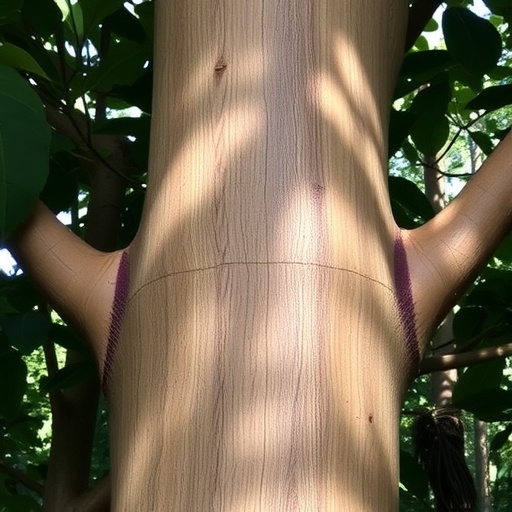In an era defined by escalating climate change, the resilience of forest ecosystems has become an urgent global concern. These complex biomes, especially tropical forests, are increasingly vulnerable to shifting environmental conditions such as rising temperatures, altered precipitation patterns, and the heightened incidence of extreme weather events. Trees, with their long lifespans and stationary nature, face unique challenges as they cannot quickly migrate or adapt within a short timeframe. Understanding the genetic mechanisms underpinning their adaptability is crucial for developing effective forestry management strategies that can withstand the pressures of a warming planet.
A pioneering study led by researchers at the University of Tsukuba has delved into the genomic adaptation of teak (Tectona grandis), a tropical hardwood tree species of immense economic and ecological value. Teak, celebrated for its durable timber and widespread use in furniture making, spans a natural distribution from the Indian subcontinent through Indochina and has been cultivated extensively across approximately 65 countries worldwide. The study offers a thorough investigation into how teak populations genetically adapt to local climatic variables, with a focus on Java Island in Indonesia—a key region for teak forestry.
The research capitalized on an innovative approach by analyzing genomic data derived from both natural teak populations native to Java Island and cultivated specimens from local plantations. By establishing an international common garden trial, the team was able to control for environmental variables while assessing the genetic variability within and between teak populations. This method allowed for precise identification of polymorphic DNA sites — segments of the genome exhibiting variation — that correlate strongly with temperature, a critical factor in adapting to climate fluctuations.
This genomic scrutiny revealed distinct distribution patterns of genetic polymorphisms, suggesting adaptive differentiation among teak populations. The insight that specific DNA regions are temperature-associated opens new avenues for understanding how this species may respond to ongoing and future climate stresses. Moreover, integrating genomic data with climatic parameters enabled the researchers to evaluate not just static adaptation, but the dynamic resilience of different teak populations to fluctuations in both temperature and precipitation.
Remarkably, among the populations studied, those originating from southern India displayed the highest genomic adaptability. This finding highlights the potential of leveraging genetic material from naturally resilient populations to inform forestry practices globally. Incorporating such insights into afforestation and reforestation initiatives could markedly enhance the ability of teak forests to thrive under erratic and evolving climate conditions, securing economic and environmental benefits.
The implications of these genomic discoveries extend beyond basic scientific understanding; they present practical solutions for the forestry sector. As teak is widely cultivated for commercial purposes, integrating genetic adaptability assessments into early-stage planting strategies represents a significant advancement in sustainable forest management. Doing so ensures that newly established plantations possess an inherent resilience, reducing vulnerability to climatic extremes and safeguarding timber yields.
Furthermore, this research underscores the broader significance of preserving genetic diversity within forest species. Genetic diversity serves as the foundation for adaptive potential, offering a buffer against the unpredictable nature of climate change. Strategies that prioritize conservation and utilization of genetically diverse germplasm could serve as models for other economically valuable tree species facing similar environmental pressures.
The techniques employed in this study—particularly the coupling of genomic sequencing with environmental data mapping—demonstrate the power of modern molecular biology in addressing ecological challenges. This integrative approach allows the identification of adaptive loci, which could be targeted in selective breeding programs or gene editing endeavors aimed at enhancing resilience. Such biotechnological applications hold promise for future-proofing forestry resources in the face of unprecedented climatic shifts.
Moreover, the research conducted on Java Island is emblematic of international scientific collaboration aimed at sustainable development. Partly funded by the Science and Technology Research Partnership for Sustainable Development (SATREPS), the project exemplifies how joint efforts can yield insights that transcend national boundaries, benefiting the global community. Sharing genomic data and adaptive strategies accelerates progress toward more resilient forest ecosystems worldwide.
These findings also prompt a reevaluation of conventional forestry management paradigms, which often rely heavily on monocultures or genetically uniform plantations vulnerable to pests, disease, and climatic stresses. Integrating genomic adaptability into forest planning promotes diversity and robustness, principles essential for ecosystem stability and long-term productivity.
In light of accelerating climate unpredictability, this study offers a beacon of hope by illuminating pathways through which forestry can evolve to meet contemporary environmental challenges. The harnessing of genomic knowledge to guide planting strategies represents a convergence of science and practical application that could redefine sustainable tropical forestry. Ultimately, enhancing the resilience of teak forests contributes not only to economic sustainability but also to carbon sequestration and global biodiversity conservation.
As climate models predict continuing trends of warming and altered rainfall patterns, the ability to predict and enhance tree species’ adaptability becomes indispensable. This work builds a critical foundation, demonstrating that genomic analysis can inform targeted, adaptive planting schemes that may mitigate the deleterious effects of climate change while supporting livelihoods dependent on forest resources.
The study’s focused attention on teak—a cornerstone species in tropical forestry—cements its importance within the broader framework of environmental science and economic forestry management. Its revelations about localized genetic adaptation poised to inform resilient planting strategies on Java Island stand to influence forestry operations globally, inspiring a new era of climate-conscious reforestation efforts.
Subject of Research: Genetic and genomic adaptation of teak (Tectona grandis) to local climate conditions for enhancing forestry resilience.
Article Title: Genomic adaptation in teak (Tectona grandis) to local climatic conditions and implication for resilient planting strategies on Java Island
News Publication Date: 23 June 2025
Web References: https://doi.org/10.1080/21580103.2025.2519469
References:
——
Image Credits: University of Tsukuba
Keywords: Forestry, Trees, Climate change, Local adaptation, Genetic diversity




